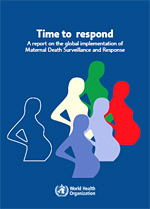
Overview
Understanding exactly why a woman died in pregnancy or around the time of childbirth is a crucial first step towards preventing other women dying in the same way. As well as identifying the medical causes of death, it is important to know the woman’s personal story and the precise circumstances of her death. Where was she when she died? Did she and her family realize she needed emergency care? Was care available to her and was it of good quality? Were there obstacles to her accessing care?
In 2004, a WHO publication, Beyond the Numbers, highlighted the importance of answering such questions and of taking action on the results. It set out the essential information required – including how many mothers are dying, where, when and why – to inform the design of targeted policies and programmes that work towards the elimination of preventable maternal deaths.
Maternal death surveillance and response (MDSR) is a relatively new approach to investigating maternal deaths and taking action based on the findings, which has evolved from the established system of maternal death review (MDR). It builds on MDR by stressing the importance of follow-up action (response) and of continual monitoring to ensure that recommendations are acted on. As a result, MDSR has been described as a “continuous action cycle for monitoring of maternal deaths”. The approach is new but the elements of MDSR have developed over several decades.
There has been a sharp increase in the number of countries adopting national policies to review maternal mortality since the publication of the first report of the Commission on Information and Accountability (CoIA) for Women’s and Children’s Health in 2011, which called for “better information for better results”. The MDSR Working Group published technical guidance in 2013 and numerous countries have begun to create MDSR systems by adopting policies for the essential components.
Detailed information about the extent and quality of implementation in each country has been largely unavailable due to the recent origins of MDSR and the lack of systematic data collection. The WHO-MNCAH policy indicator database provides some useful information but is of limited relevance to MDSR because it addresses the whole spectrum of maternal, newborn, child and adolescent health.